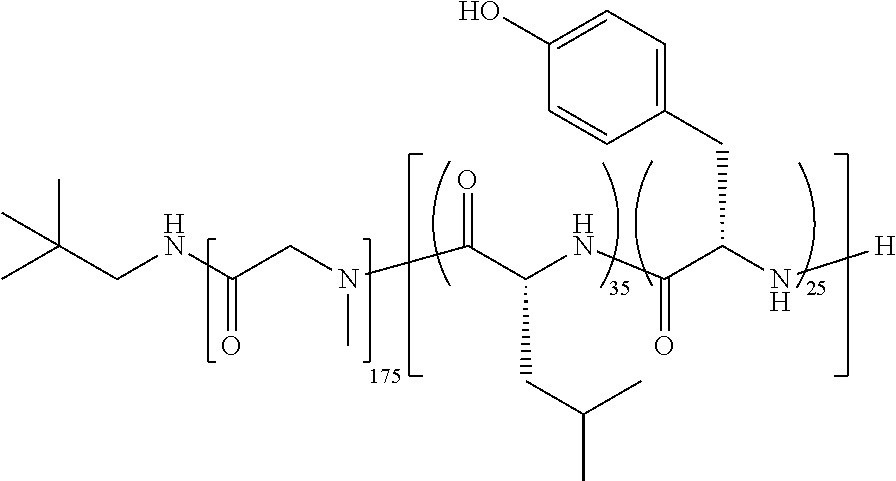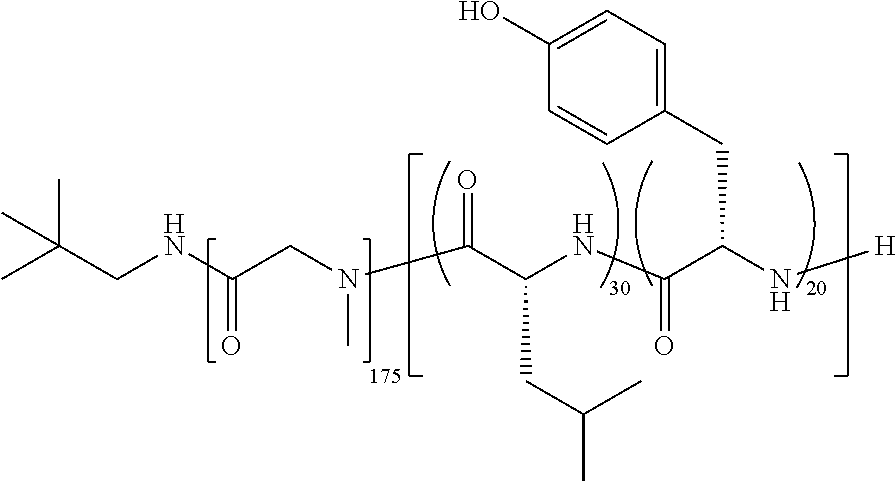Polymer excipients for drug delivery applications
- Summary
- Abstract
- Description
- Claims
- Application Information
AI Technical Summary
Benefits of technology
Problems solved by technology
Method used
Image
Examples
example 22
axel Feed with TFS-2
[0239]2.0 g of TFS-2 (poly(Sar)175-block-poly(d-Leu30-co-Tyr20)) and 2.0 g of trehalose were dissolved in 90 mL of 30:70 (v / v) tert-butanol: water to produce a solution of 22.2 mg / mL of each component. The pH of the resulting solution was adjusted to pH 7.0 using 25 mM NaOH. Separately, paclitaxel (603 mg) was dissolved in 30 mL of tert-butanol with the assistance of a sonicating water bath, to produce a solution of 20.1 mg / mL. The two solutions were mixed and stirred for 15 minutes before filtering through a 0.22 μm PVDF filter. The formulation solution was then transferred to 20 mL vials in 10 mL aliquots per vial, frozen at −80° C., and then lyophilized for 2 days. This yielded 4.2 g of a fragmented white cake containing paclitaxel at a weight loading of 12.9%.
example 23
axel Feed with TFS-2
[0240]100 mg of TFS-2 (poly(Sar)175-block-poly(d-Leu30-co-Tyr20)) and 100 mg of trehalose were dissolved in 10 mL of 40:60 (v / v) tert-butanol: water to produce a solution of 10 mg / mL of each component. The pH of the resulting solution was adjusted to pH 7.0 using 25 mM NaOH. Separately, paclitaxel (15 mg) was dissolved in 0.75 mL of tert-butanol with the assistance of a sonicating water bath, to produce a solution of 20 mg / mL. The two solutions were mixed and stirred for 15 minutes before filtering through a 0.22 μm PVDF filter. The formulation solution was frozen at −80° C., and then lyophilized for 2 days. This yielded the drug product as a fragmented white cake containing paclitaxel at a weight loading of 7.51%.
example 24
axel Feed with TFS-1
[0241]Using the general method of Example 23 with the following exception: the copolymer used was TFS-1 (poly(Sar)175-block-poly(d-Leu35-co-Tyr25)). This yielded the drug product as a fragmented white cake containing paclitaxel at a weight loading of 6.90%.
PUM
| Property | Measurement | Unit |
|---|---|---|
| Percent by mass | aaaaa | aaaaa |
| Percent by mass | aaaaa | aaaaa |
| Structure | aaaaa | aaaaa |
Abstract
Description
Claims
Application Information
 Login to View More
Login to View More - R&D
- Intellectual Property
- Life Sciences
- Materials
- Tech Scout
- Unparalleled Data Quality
- Higher Quality Content
- 60% Fewer Hallucinations
Browse by: Latest US Patents, China's latest patents, Technical Efficacy Thesaurus, Application Domain, Technology Topic, Popular Technical Reports.
© 2025 PatSnap. All rights reserved.Legal|Privacy policy|Modern Slavery Act Transparency Statement|Sitemap|About US| Contact US: help@patsnap.com



